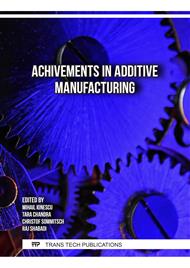p.79
p.85
p.91
p.97
p.103
p.109
p.117
p.123
p.129
Effect of Relative Weight on Compression Behaviour of 3D Printed Porous Structure Made of Aluminium Alloy
Abstract:
Metamaterials, including materials with regularly distributed porous structures, are currently a very intensively developing area of the technology industry. They bring a number of advantages compared to components produced in the classic way. The primary focus of such porous structures is to lighten the product and at the same time preserve its physical or mechanical properties, which subsequently conveys benefits in the form of saving material for the production of the device, and when used in aeroplanes or cars, they also save the amount of fuel consumed, so it can be said that such products and equipment are more user-friendly and environmentally friendly. There are many types of structures with different configurations, different types of basic cells, and different distributions of pores or their topology, so it is very important for the designer to know and decide which type of structure is most advantageous to use in the proposed product that will be subjected to a specific load. The article deals with the investigation of the mechanical properties of porous structures produced by the Direct Laser Metal Sintering (DLMS) method. It is focused on experimentally tested samples made of AlSi10Mg alloy with the Neovius structure, which were produced with four different relative weights. Results of quasi-static pressure testing at a crossbar speed of 10 mm/min (testing machine 250 kN Instron 8802 servo-hydraulic machine) point out that the trend of the influence of the relative weights on the First Peak Local Maximum best described by a second-order polynomial function.
Info:
Periodical:
Pages:
103-107
Citation:
Online since:
November 2023
Price:
Сopyright:
© 2023 Trans Tech Publications Ltd. All Rights Reserved
Share:
Citation:



